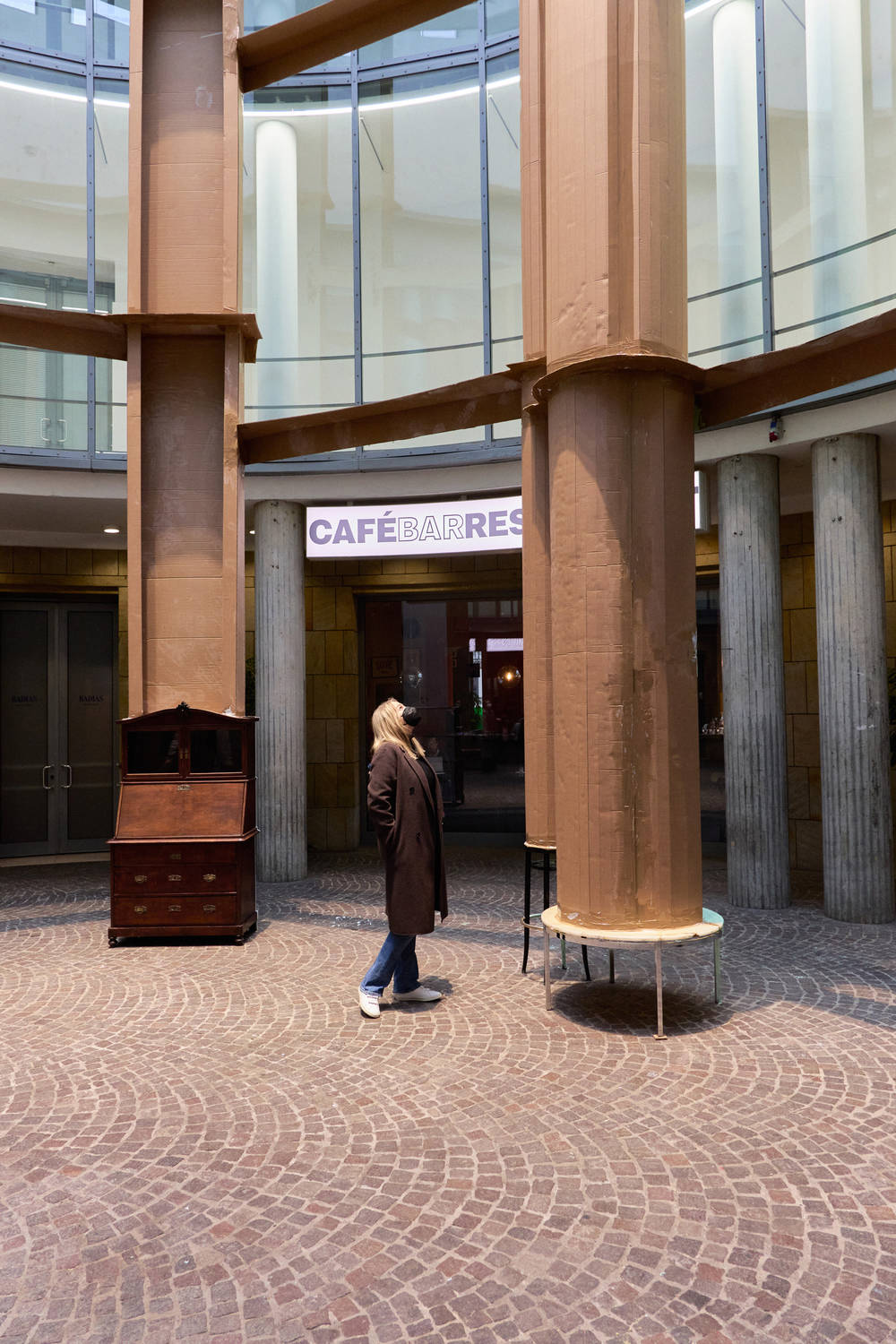In the context of the WALK! exhibition, Carlos Bunga has realized an installation in the Schirn Rotunda. Moving between architecture, painting, and performance, he addresses the themes of home country and home – and leaves it to the viewers to decide on the interpretation.
The Schirn Rotunda is a fixed part of Frankfurt’s profile. Be it en route to an exhibition or while crossing the Römer to the new Old Town, for many Frankfurt citizens it is now so much a matter of course as to be almost invisible. At the same time, the rotunda is repeatedly a popular subject chosen for photos, because it is constantly changing with each new installation by contemporary artists. Carlos Bunga’s installation “I always tried to imagine my home” embroils the viewers in a surreal game of spatial doublings. With its aesthetics of transience, it places the rotunda itself in a new light..
What do you see?
The overall structure of the installation can be swiftly described – and yet it is not easy to describe. In terms of basic shape, it consists of a circle within a circle. In front of each of the eight characteristic double-pillars made of concrete, one or two pieces of vintage furniture stand directly on the paving stones. The items include a low round table with a bar stool, an upholstered armchair covered in white velvet, a sideboard made of dark wood with glass doors, and a solid desk. Aligned to the center of the space, the furniture stands around as if in a living room without walls, and each item bears towering cardboard columns. These prompt you to look upward, almost up to the base of the glass-covered dome.
An architectural doubling up
Horizontal cross-struts that are likewise made of cardboard connect and stabilize the columns. Since they follow the height of the stories of the Schirn, whose position is visible through the glass inner skin of the rotunda, they strengthen the sense of an architectural doubling up, something already triggered by the pillars, which for their part correspond to sections in all the stories of the Schirn’s building. In terms of size and shape, the installation’s columns adapt to the items of furniture in the installation, out of which they seem to grow upwards. On closer inspection, it becomes clear that they are glued in place with brown packing tape – an unconventional way of interconnecting architectural elements. Some of the columns open up on the inside and reveal their hollow interior, others are sealed right round. On their “reverse side” as it were, which points outward, the entire installation has been painted alternately with white, blue, turquoise, and yellow paint.
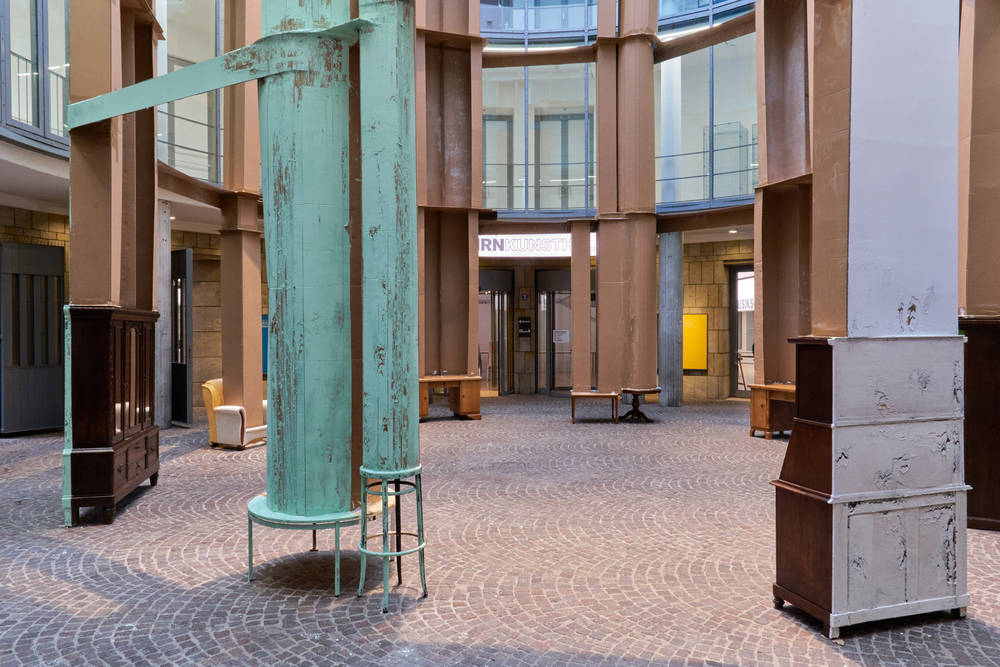
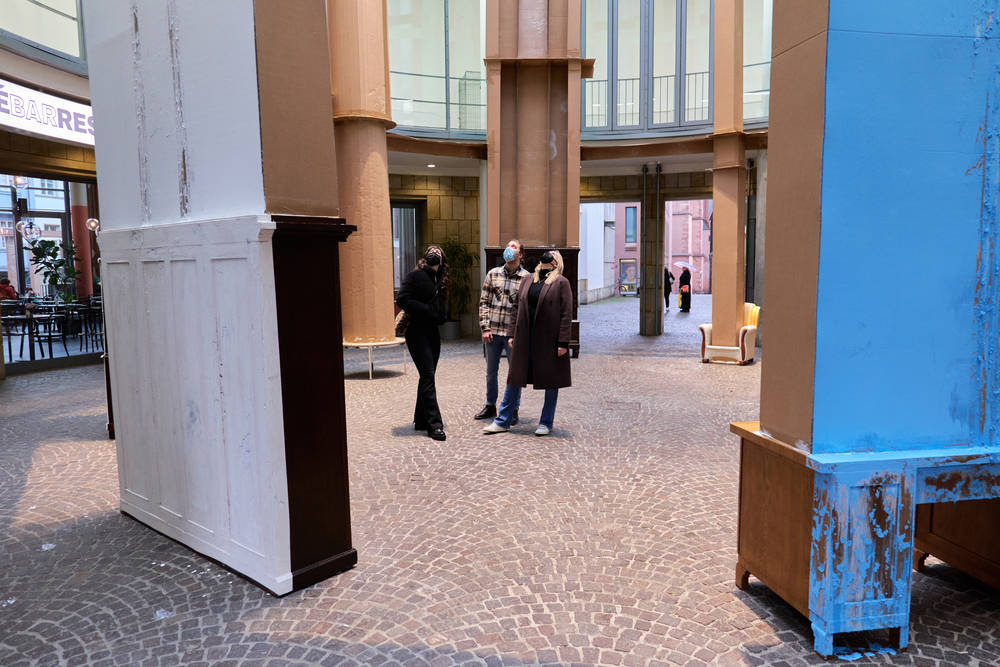
What’s it about?
Even without knowing more about the artist or his work, one can easily discern that the piece is definitely site-specific. This applies not only to the structure itself but also to the furniture, which originated in a Frankfurt junk store and thus likewise has a local reference. Although we do not know the detailed personal history of each item of furniture, it is latently present and tangible. For this reason, the furniture items are not just material and load-bearing elements but also the seedbed for the content of the installation. They kindle the association with an interior and convey a strange sense of intimacy since they (at least ostensibly) offer us insights into the private life of unknown people.
However, Bunga has not installed a homely living room in the rotunda, and instead works with the theme of alienation. He breaks with traditional notions and habits. With the improbable encounter of paving stones and living-room atmosphere, Bunga is not least commenting on the location, which is neither an outdoor nor an indoor space, or is precisely both at once. As the piece’s title “I always tried to imagine my home” reveals, the work is also about a more abstract, intangible, fragile, and fleeting notion of home and home country. Bunga, who likes to describe himself as a nomad (in the metaphorical sense, as he and his family have in fact lived for several years in Barcelona), contrasts the feeling of restlessness and constant searching with an imagined notion of home and secure comfort in order to show that the two are mutually determining.
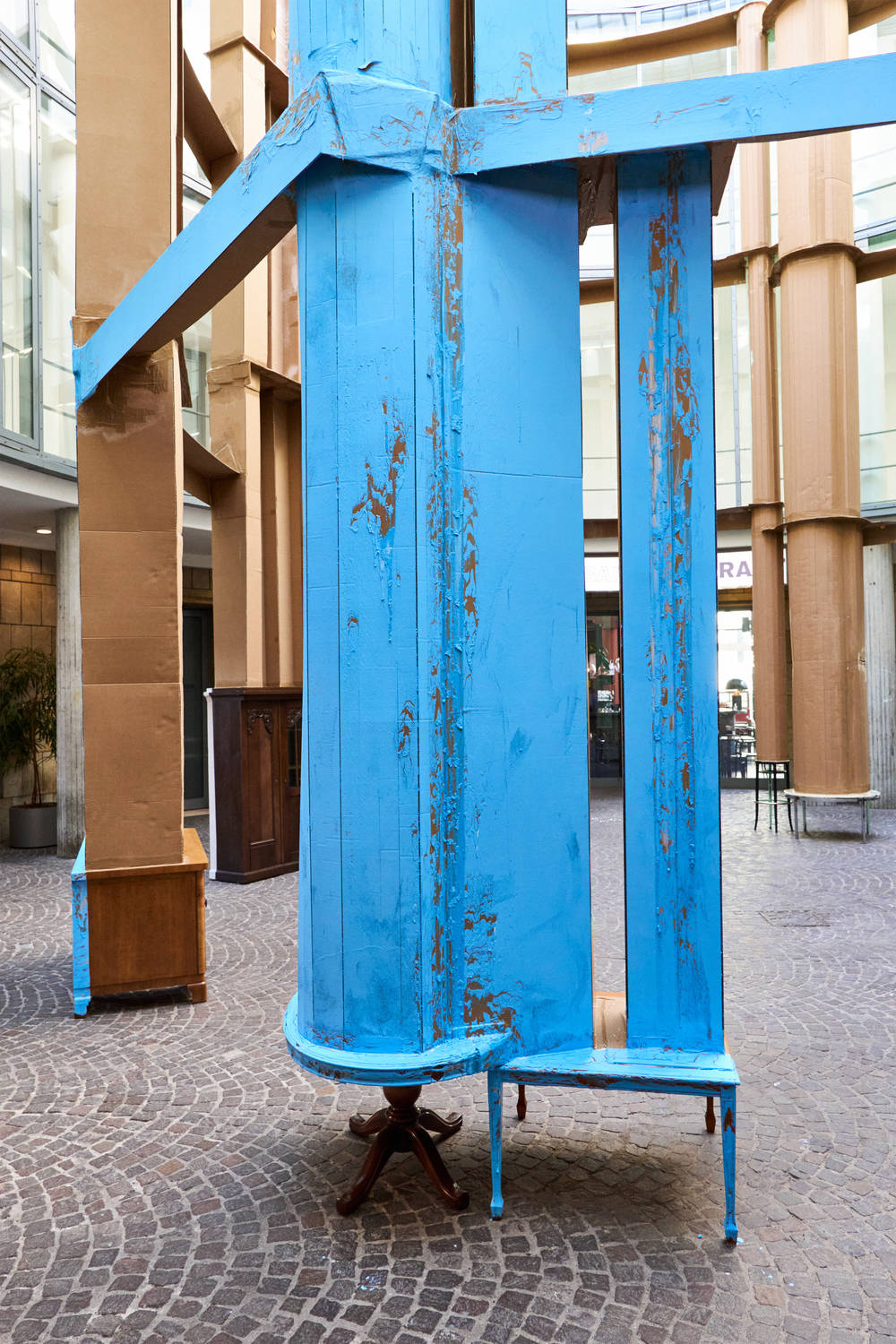
Painting becomes architecture
With his works, Carlos Bunga explodes the lines dividing the different media and the genres. If you ask him in what medium he works, he tends to start by saying painting. Painting was the focus of his art studies and to this day remains his entry point into art. For the installation in Frankfurt, the use of paint is likewise key. The color tones he has chosen are to be encountered frequently in Bunga’s oeuvre and conjure up associations with his native country of Portugal without, however, directly referencing it. The paint seems matt and porous, and has peeled off in some places, which serves to underscore the aforementioned aesthetics of transience and the fact that the work is a matter of process and has a limited lifeline.
In interviews, Bunga emphasizes that as a student he became increasingly dissatisfied with the scope painting offered him and searched for ways of expanding the medium into the surrounding space. He thus went down a path that art has been taking ever since the post-war decades – for example in the context of Post-Minimal Art. Bunga initially took the spatialization of painting literally and, for example, created a painting in the shape of a canvas with a vertical zip fastener in the middle.
The work as a walkable space
In a performative activation of the piece, he opened the canvas in order to then step into it and thus to denote it as a space that could be entered. At the same time, driven by a fascination with the beauty of ruined buildings, he started reflecting on the creative-painterly character of our built environment. From there it was no longer a giant leap to consider architecture as painting and painting as architecture. In his installations the two media blend into a large, designed whole.
Painting was the focus of his art studies and to this day remains his entry point into art
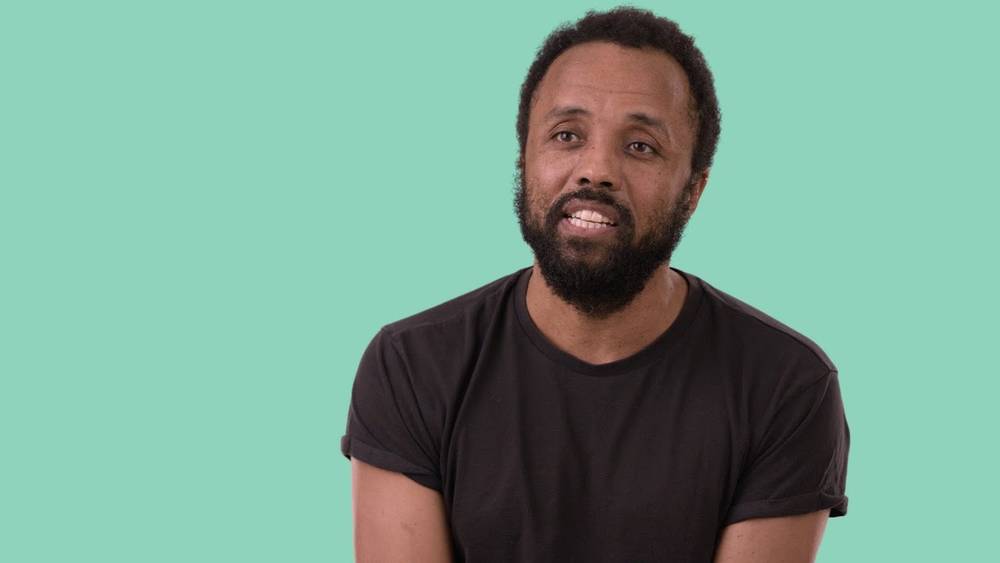
Architecture becomes performance
Bunga’s rotunda installation obeys the classical structural principle of loads and load-bearing properties and gives rise to a temporary architectural space. Through imitation of the surrounding architecture, attention is deliberately directed toward the rotunda’s architecture. One could say that the ephemeral ‘copy’ renders the ‘original’ more visible and invites viewers to ponder how it is constructed and its transience. Because even ‘solid’ architecture is only ostensibly permanent. Thus, in the course of planning the new Old Town, there was already talk of removing the rotunda and a small part of the Schirn – the so-called ‘table’, was actually torn down in this context.
Temporary and easily moldable materials
Despite the great affinity with architecture, Carlos Bunga does not proceed like a classical architect, who addresses measurements, plans, and load-bearing properties. Instead, he consciously works without plans, models, or sketches. When he draws, then it is not until after the installation is complete, and then he does so in order to concern himself more with the piece. His preferred materials (cardboard, adhesive tape, and paint) are also temporary and easily molded. All of that is important as his works deliberately arise in direct, physical interaction with the location. They grow as it were organically out of it, which leads to a special reference between the artwork and its surroundings.
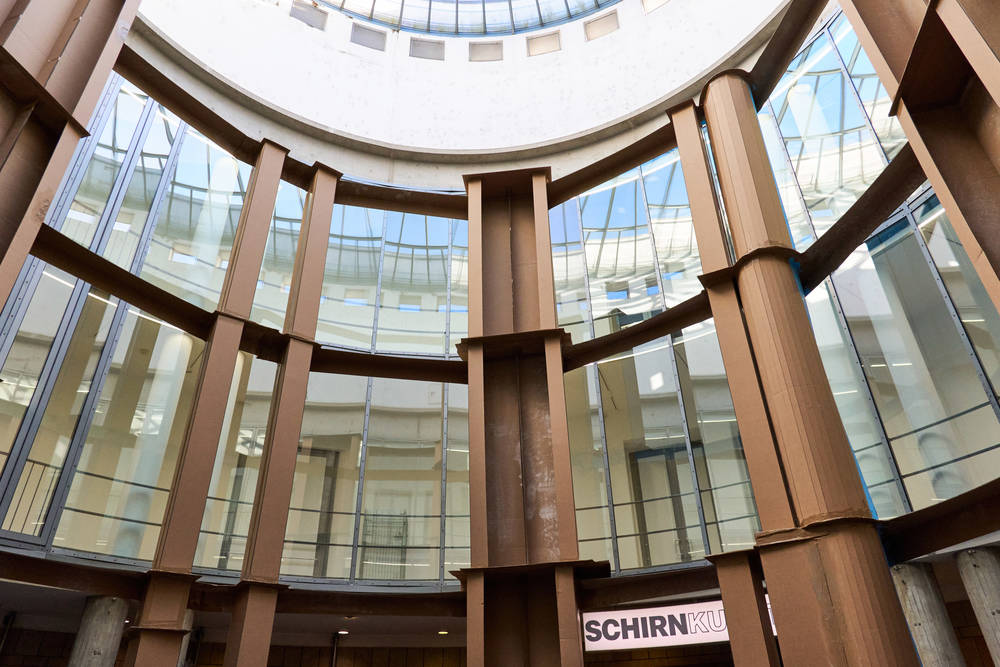
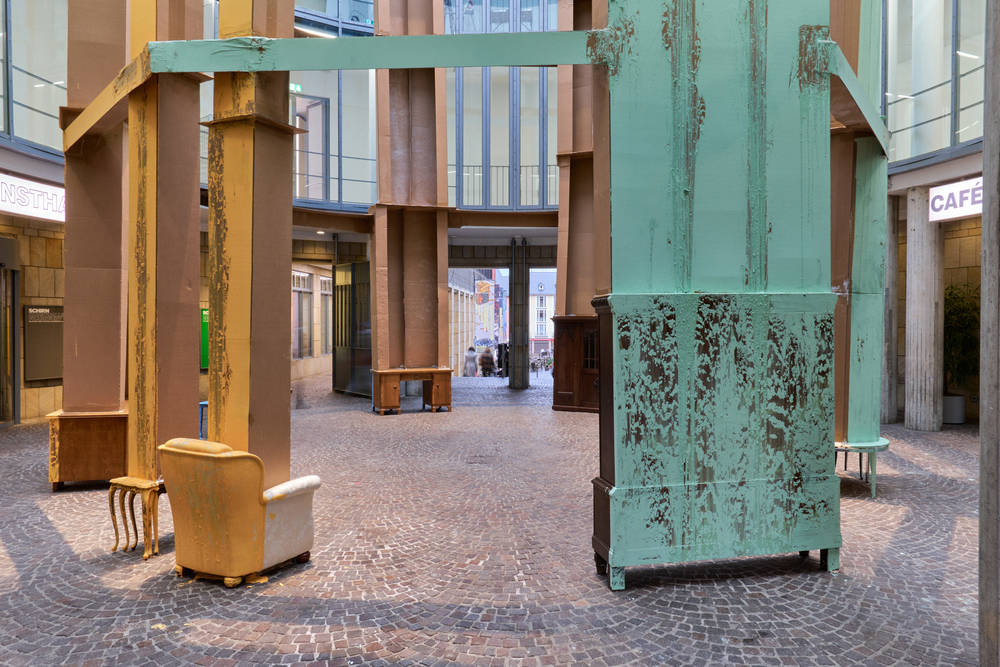
[Translate to English:]
Bungas Installation gibt keinen Betrachter*innenstandpunkt vor. Um sie in ihrer Gesamtheit zu erfahren, muss sie durch- und umschritten werden. Damit hält sie für die Betrachtenden eine körperliche Erfahrung bereit. Sie provoziert einzutreten, im Gehen (WALK!) zu erkunden und damit Teil des Werks zu werden. Auf diesen performativen Aspekt legt Bunga besonderen Wert. In der Vergangenheit lud er sogar professionelle Performer*innen zur Interpretation seiner Arbeiten ein. Für die meisten seiner Installationen – das wird auch in Frankfurt der Fall sein – inszeniert er zum Abschluss der Ausstellungsdauer ihre performative Zerstörung beziehungsweise De-Konstruktion. Diesem durchaus gewaltsamen Akt zum Trotz geht es dem Künstler nicht um Zerstörung, sondern erneut um den Prozess und die Flüchtigkeit, mit der immer auch das Versprechen von Erneuerung und Transformation einhergeht.
